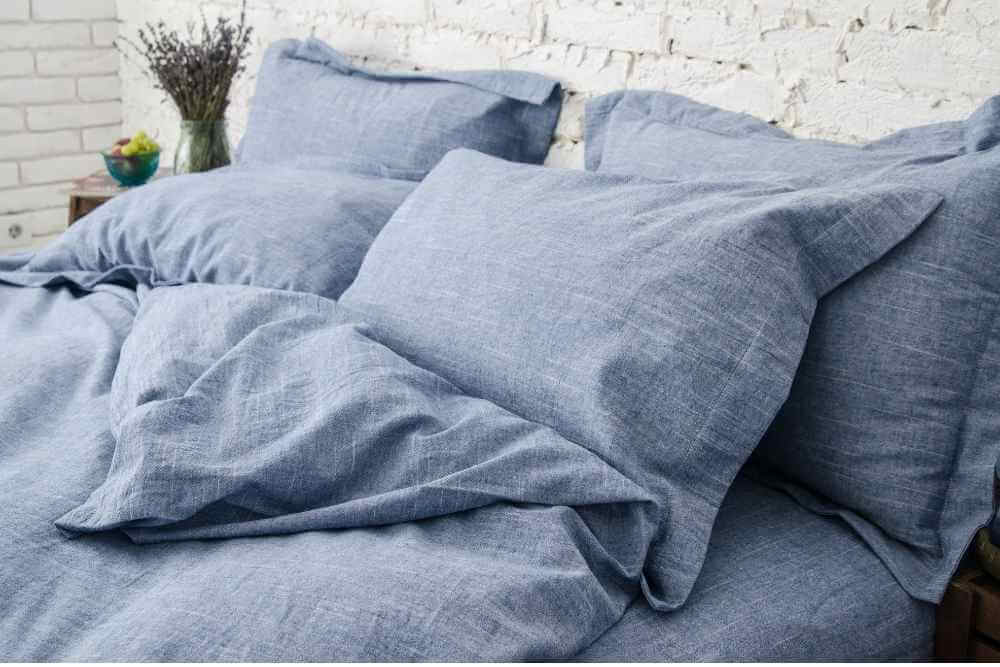Linen sheets have an effortless and stylish charm that can make any bed look inviting.
They’re also known for their signature wrinkles, which create a refined but laid-back aesthetic.
Made from flax plant fibres, linen is durable and breathable. Its unique fibre structure also helps regulate body temperature, keeping you warm in winter and cool in summer.
However, some linen sheets can feel quite stiff when new. But don’t worry, linen naturally softens with every wash!
Just be mindful, as washing linen sheets incorrectly can wear them out too soon.
But with proper care, your linen bedding can stay cosy and charming for many years.
Pre-Treating Stains | Washing | Drying | Whitening | Care Tips
Before Washing Linen Sheets
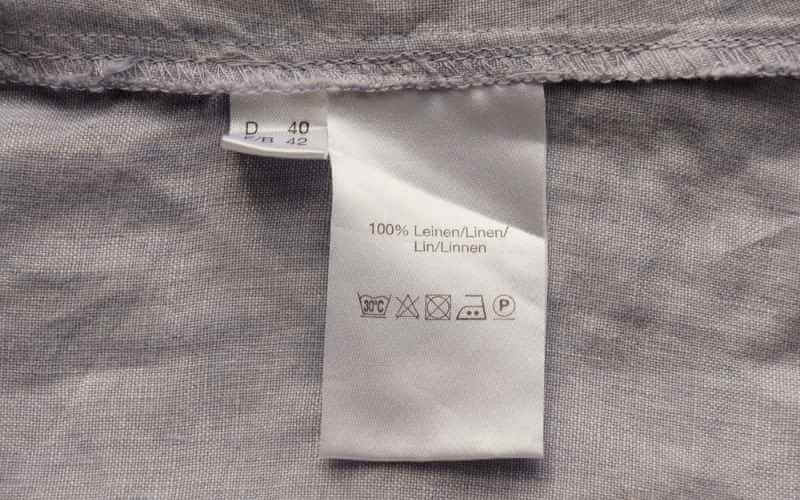
Before washing your linen sheets, read the care label first.
Some sets can handle warm water, while others require a cold wash.
The label will provide specific washing and drying instructions to keep your linen sheets in their best shape.
For thorough cleaning, wash linen sheets in their own cycle.
If you must wash them with other items, only pair them with similar fabrics and colours.
Make sure to avoid overloading the washing machine so your linen sheets can move freely during the wash.
Also, do not use bleach and fabric softeners on linen sheets. Bleach can weaken the linen fibres, and softeners often leave residue on fabrics.
Don’t forget to pre-treat any stains and double-check that they’re all gone before washing the sheets.
Pre-Treating Stains on Linen Sheets
It’s important to tackle any stains on your linen sheets immediately.
Since linen is highly absorbent, stains can quickly sink into the fibres. If left for too long, they’ll become tougher to lift.
First, remove the stained sheet from the bed to avoid spreading the mess to other bedding.
Then, spot-test any stain remover on a hidden area — some cleaning products can fade or damage the fabric.
Blood stains
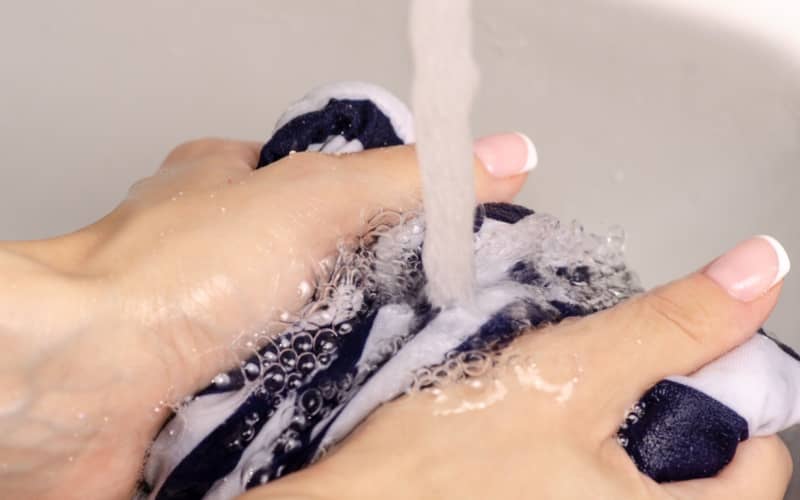
Salt water is a mild but effective way to get blood out of linen sheets.
First, turn the sheet inside out. Hold the fabric under cold running water to flush out as much blood as possible.
In a basin, mix 1 tbsp of salt per 1 cup of cold water. Soak the stained fabric in this solution for 10–15 minutes.
Rinse the sheet thoroughly. If any blood stain lingers, repeat the steps until it’s completely gone.
Food and drink stains
To clean food or drink stains off linen sheets, use baking soda!
Make a thick baking soda paste. Apply it directly onto the stain and let it sit for 15–30 minutes.
If needed, you can gently rub the stain with a soft cloth or sponge to loosen it.
Afterwards, wash the baking soda off the sheet with cold running water.
Makeup stains
First, carefully remove any solid makeup bits from the linen sheet. Then, apply a bit of dish soap to the stain.
Lightly rub the affected area to work the dish soap into the fabric. Wait for 15–20 minutes, then rinse thoroughly.
Sweat stains
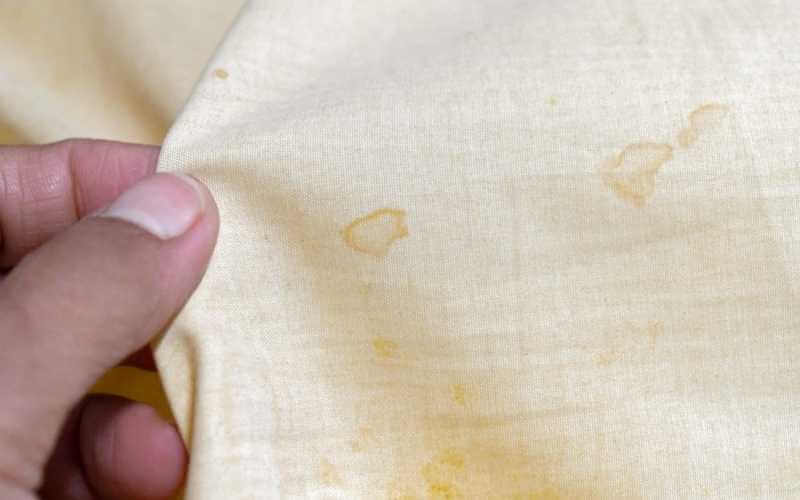
Sweat can cause yellowish spots on fabrics. To get sweat stains out of linen sheets, try white vinegar.
Mix equal parts vinegar and water in a spray bottle. Spray the affected area with this solution, and allow it to sit for 15–30 minutes.
Afterwards, rinse the sheet with cold water, then check if the stain is gone.
If not, repeat the steps until the stain has lifted.
Urine stains
Enzyme-based cleaners are effective for urine stains. Choose a product that’s suitable for natural fibres like linen.
Follow the product’s instructions carefully. After the treatment, check if the stain has lifted.
You can also add baking soda to the wash cycle to remove any lingering urine smell from your linen sheets.
Should You Wash New Linen Sheets Before Use?
Manufacturers often pre-wash linen sheets so they’re ready to use right away.
Some even use stone washing — which involves natural stones like pumice and volcanic rocks — to give linen sheets a more “lived-in” look.
The product label will typically indicate if the sheets have been pre-washed.
Still, we recommend washing new linen sheets at home before use.
This removes any dirt or dust that may have collected on the fabric during packaging and shipping.
Plus, this will make your linen sheets even softer!
How to Wash Linen Sheets Correctly
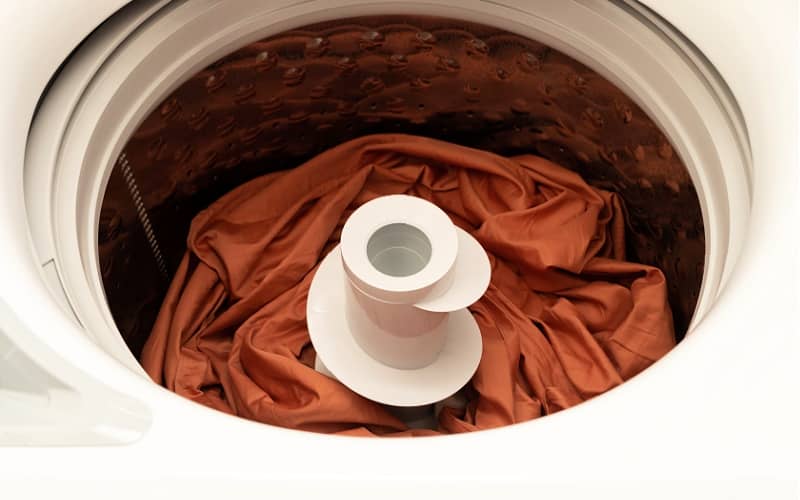
While linen sheets are often considered high-end, this doesn’t mean they’re high-maintenance.
Linen sheets are easy to care for, as the durable flax fibres can handle frequent washes.
To preserve their quality, machine wash linen sheets on a delicate or gentle cycle.
Use cold (below 30°C) or warm water (30°C–40°C), according to the care label.
However, avoid using hot water (over 40°C), as this can shrink linen fabrics.
Choose a mild detergent, ideally one that’s designed for natural fibres, like wool wash.
Another option is a detergent that’s formulated for sensitive skin.
Always follow the product instructions for how much detergent to use.
If you don’t have a specialised detergent, a regular one can also work, but use a smaller amount than recommended.
How to Dry Linen Sheets
Air drying is the best way to dry linen sheets, as it’s gentler on the fabric.
You can also tumble dry linen sheets, but only on low heat!
How to air dry linen sheets
To air dry linen sheets, hang them on a clothesline or a drying rack, ideally in a shaded area.
Letting the sheets air dry is safer for the flax fibres! It also minimises wrinkles.
Avoid exposing linen sheets to direct sunlight for an extended time, since that can fade the colour and make the fibres brittle and stiff.
How to tumble dry linen sheets
If you need to speed up the drying process, you can put linen sheets briefly in the dryer.
Be sure to use the lowest heat setting. High temperatures can weaken linen’s natural strength and shrink the fabric.
Run a 10-minute spin cycle, then remove the sheets while they’re still damp.
Finish by line drying the linen sheets in a shaded area to prevent excessive wrinkling.
How to Whiten Linen Sheets
To keep your linen sheets bright, choose gentle whitening treatments and avoid harsh chemicals like chlorine bleach.
Two mild (yet effective!) options are baking soda and white vinegar.
Baking soda not only helps lift stains but also boosts the cleaning power of detergents.
To use it for whitening, add half a cup of baking soda to the wash cycle.
Alternatively, white vinegar can brighten — and also soften — your bed linens.
Simply add half a cup of white vinegar to the final rinse cycle to break down any residues from detergents or hard water.
Another way to brighten linen sheets naturally is to expose them to direct sunlight.
First, let the sheets dry in a shaded area. When they’re almost dry, hang them under direct sunlight for 10-15 minutes.
Avoid prolonged sun exposure to protect the linen fibres from intense heat.
Keeping Linen Sheets in Top Shape
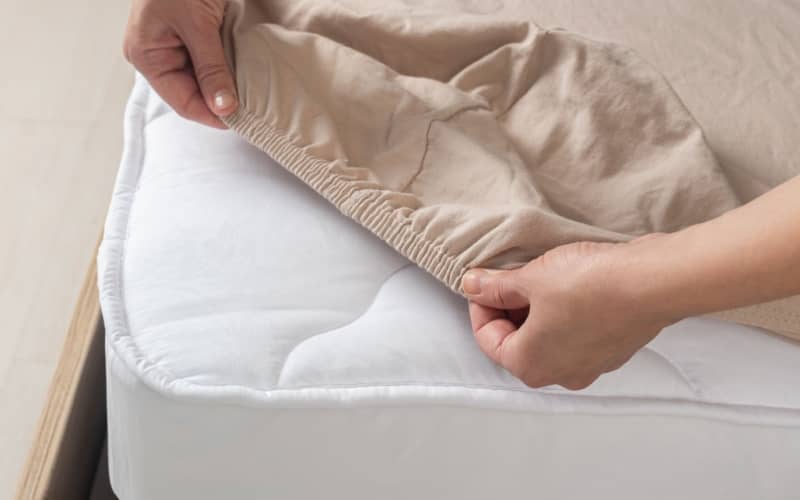
Linen bedding — especially French flax linen and other European linens — is pricier than standard cotton sheets.
It’s worth taking a little extra care to prolong your sheets’ lifespan!
To prevent dirt build-up on the fabric, change and wash your sheets regularly — once a week is ideal.
If you use a linen duvet and other bedding, clean them routinely as well. This can help prevent dirt and stains from transferring to your sheets.
For added convenience, you can book a recurring cleaning service to assist with your laundry and other household chores.
It’s also best to rotate between two or three sets of bed sheets. Though linen is durable, using just one set can speed up wear and tear on the fabric.
After washing and drying your linen sheets, fold them neatly but loosely to minimise wrinkles.
Place the sheets in a breathable fabric bag or container, and keep them in a cool, dry place.
FAQs: More About Washing Linen Sheets
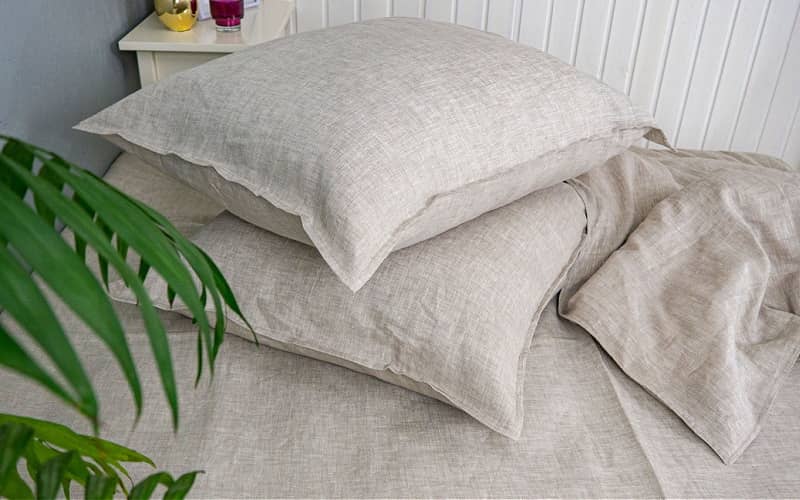
Discover more about how to care for your linen bedding!
Can you machine wash 100% linen?
Yes, you can machine wash a 100% linen fabric, but it’s important to use a delicate or gentle cycle.
Linen can be washed in cold or warm water. Check the care label for the correct water temp to use, and opt for a mild detergent.
Should you hand wash linen sheets?
Hand washing is usually not necessary for linen sheets, as they’re machine washable.
If you must hand wash your linen sheets, fill a tub or a large basin with cold or warm water, based on the care label.
Mix a mild detergent in the water, and soak the linen sheets in the solution for 15–30 minutes.
Gently rub the fabric against itself to help loosen dirt.
To rinse the sheets, drain the soapy water and refill with clean water. Keep doing this until the water runs clear.
Once all traces of detergent are gone, press out the excess water. Do not wring or twist the sheets vigorously to avoid damaging the fabric.
Afterwards, hang linen sheets in a shaded area to dry.
How to soften linen sheets
To soften linen sheets, add half a cup of white vinegar to the final rinse cycle.
Vinegar acts as a natural fabric softener by breaking down residues from detergent and hard water.
Skip commercial fabric softeners as these can leave a stubborn residue that may harden or discolour fabrics.

